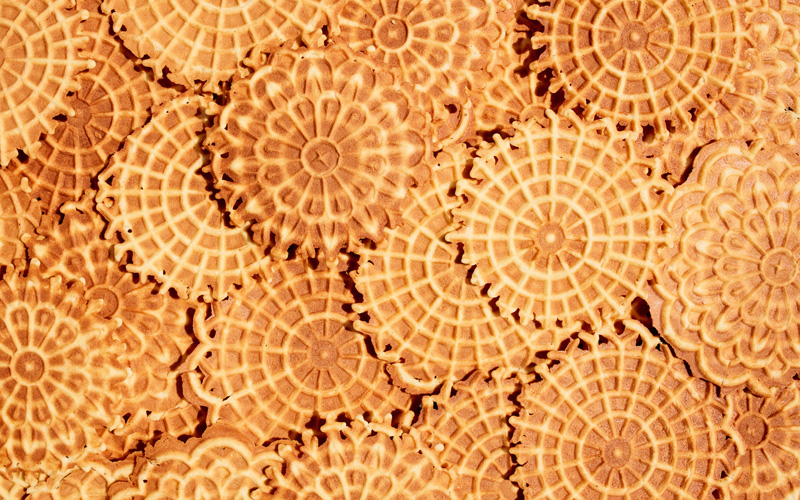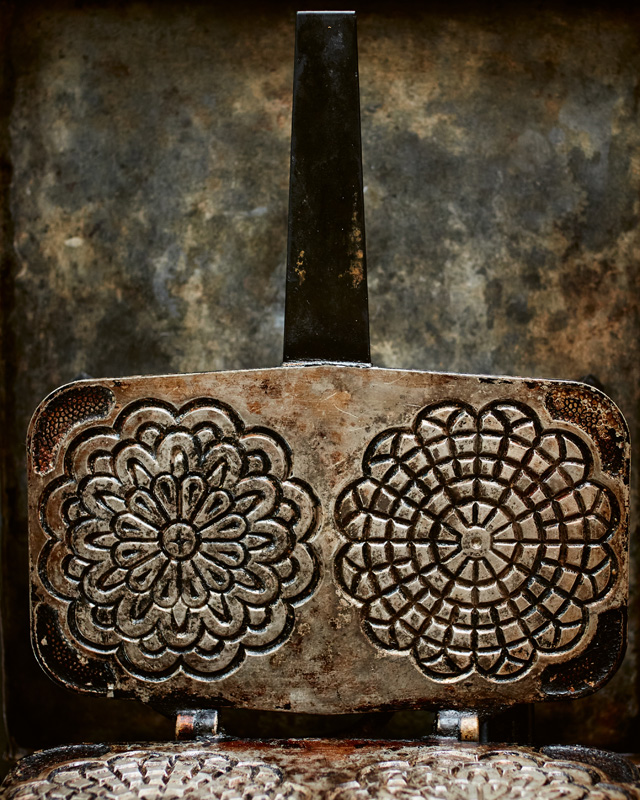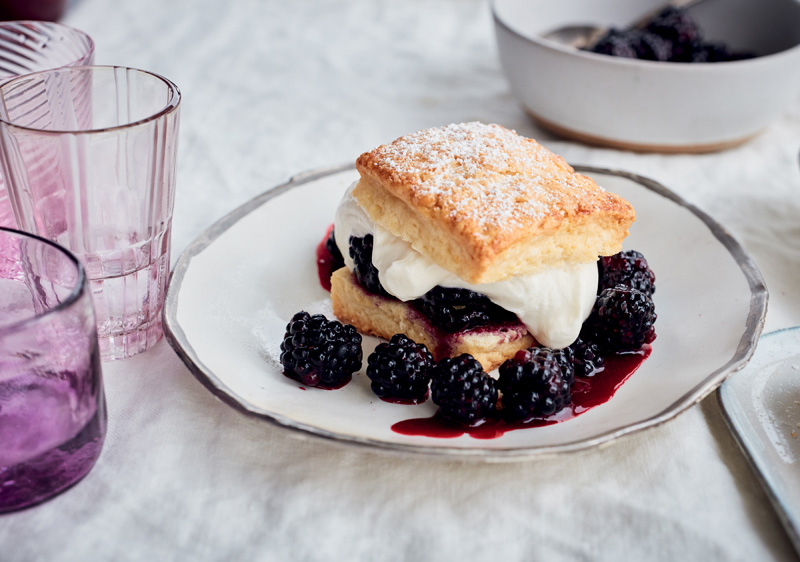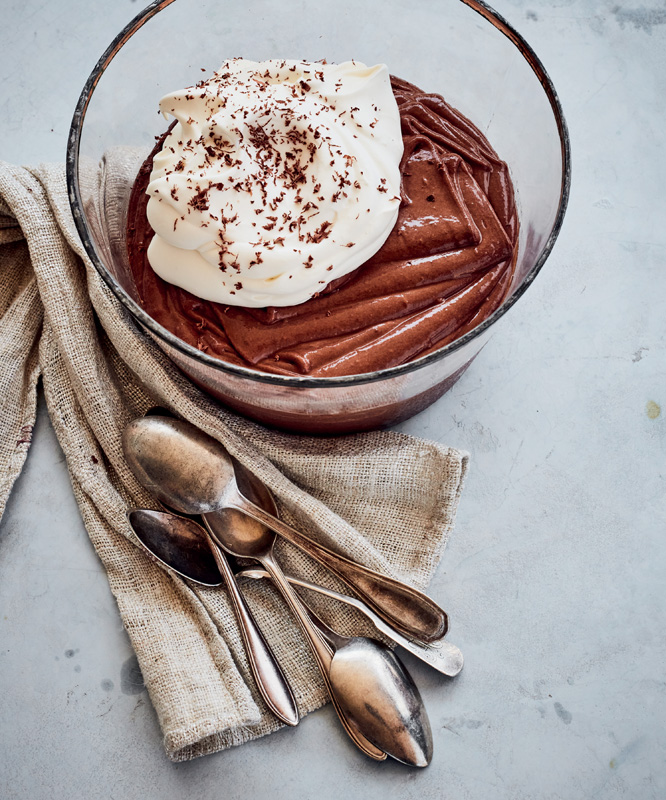Claudia last visited the Island in 2021. She caught the ferry in Orient, a few miles from her home on the North Fork of Long Island. It lands in New London, making the trip easy, especially so in April when there is not much traffic on the Cape.
Claudia brought pizzelles — not the sweet version, but a savory twist on the Italian classic. Eager for tasters, we drove up to Aquinnah to check in with a Dutch friend whose expertise we valued because of his country’s fondness for waffle cookies (in this case, flavored with cheese from his homeland). I loved Claudia’s creation, but we wanted confirmation. When the Gouda Pizzelles were a hit, we both exhaled and headed down-Island to continue baking.
Claudia and I go back — we cooked together at Tribeca Grill in 1990. I was new to restaurants, but Claudia was already a veteran. She cut her teeth working front-of-house at Jams, then Union Square Café. By the time our paths crossed, she’d shifted focus and taken up pastry with what I would learn was characteristic intensity. At Tribeca she assisted Gerry Hayden, the talented young sous-chef who ran the restaurant’s dessert department.
After two years she wanted to stretch herself, and left New York for France to stage at Fauchon in Paris and a pastry shop in Biarritz; we stayed in touch. Then in 1994 we worked together again. Claudia had honed her skills, and Tom Colicchio hired her as the opening pastry chef of Danny Meyer’s new venture. There, at Gramercy Tavern, Claudia developed a roster of desserts that led the James Beard Foundation to name her Outstanding Pastry Chef of 2000. The following year she published “The Last Course,” a cookbook that became a classic because it enabled others to replicate Claudia’s sophisticated sweets.
Claudia reconnected with her onetime boss, Gerry, at the 2000 Beard awards. They married, and then left the city to open the North Fork Table and Inn in Southold, Long Island. At the end of 2019, she said goodbye to the restaurant after 13 years. She wanted to take a step back. “Delectable: Sweet & Savory Baking” (Penguin Random House, 2022), a cookbook we wrote together, is the outcome. Claudia and I recently sat down for a chat.

People cherish your book, “The Last Course.” Why did it take so long to do another?
I was busy. Gerry and I opened the North Fork Table and Inn in 2006. We didn’t have tons of money, so we had to do everything ourselves. I was the pastry chef, and also responsible for breakfast baking. When Gerry was diagnosed with ALS in 2011, he stayed as involved as he could, but my responsibilities broadened. Gerry lost his battle in 2015, and, even though I had help from our partners and friends, I felt like it all fell on me. After five more years, it was time to sell the restaurant — I couldn’t do it anymore. I needed time.
You used the time to write a book. What should readers expect?
From my point of view, this book is entirely different from the other. It’s a collection of recipes I bake at home. I cooked everything on my electric stove. My goal with “The Last Course” was to make the multifaceted desserts we served at Gramercy accessible beyond a professional kitchen. In “Delectable,” the recipes are my baking projects — done over a year when like most, I stayed home. Some recipes are variations on things I served at the North Fork Table or Gramercy, others favorites I grew up eating, and the rest simply what I wanted or thought my friends would like.
Cooking at home is quite a change from running a restaurant.
Yes, it was. But it was what I needed. It allowed me to go slowly with each recipe, and get it where I wanted it without the pressure you have in a restaurant. I cooked for myself, conscious that I wanted to make recipes that would work for someone without restaurant training. The Apple Tartlets in the book, for example, are delicious, but have only three components: an easy cream cheese dough, apple butter (time-consuming, but a cinch), and sliced apple. You can even simplify further, and use commercial puff pastry for the crust — just roll, layer, and bake.
Was it difficult to develop recipes alone?
Honestly, it was bucolic. My kitchen is puny, but I can see the water from my little porch. I like to cook with local produce, and there are wonderful farms within a few miles. Like Martha’s Vineyard, the population ebbs after the summer vacation season, the days pass slowly, and that feels like a luxury. For pantry items, I shopped at the local grocery, which is pretty well-stocked, but doesn’t carry specialty items. Fine by me. The biggest challenges were pandemic shortages of flour and yeast. I wound up trading with a friend who kept her juice bar open.
Are you still cooking at home these days?
Not as much as I’d like. After a year I needed a job, and when restaurants began to reopen, I reached out to Danny Meyer. I’d worked for Danny at the beginning of my career, then at Gramercy. He has always been very supportive, and offered me a position as culinary director for Daily Provisions. I am responsible for menu development and execution. It’s a big job, but I like it, though it does limit my time on the North Fork.
You’ve included recipes for dishes you grew up eating. Tell me about your family.
My father was Irish, but my mother’s parents came from Sicily. She was an excellent cook, and made the food in our house. We ate chicory — never iceberg lettuce. Although I coveted “American” food, we lived in Brentwood [Long Island], and there were lots of other Italian families. I could go to the Stasis’ house the day after Christmas and know I’d find wonderful escarole pie. Thinking about my family, I remember my grandmother’s pasta con le sarde — a deeply savory, but slightly sweet, combination of sardines, fennel, pine nuts, and raisins I loved. We would visit her in the Bronx, and my mother would shop at the Italian markets before or afterward. I was happy to go with. I looked forward to the freshly baked taralli and pignoli cookies they sold.
Did your mother bake?
She baked a few things very well. For company she’d make either apple turnovers or chocolate cream pie for dessert — both really good. During the holidays she baked cookies. I can still taste her butter cookies. We also always had pizzelles. My grandmother would make hundreds, one at a time, with her stovetop iron. My aunt liked to flavor them with orange zest and liqueur. They were yummy, but I preferred plain sugar, or those flavored with fennel or anise seed.
Is the Ginger-Stout Cake in your book a family recipe?
No. I got that when I worked at Bright Food Shop, a Mexican fusion diner that used to be in Chelsea. Dona Abraham and Stuart Tarabour, the owners, were good, thoughtful cooks. Dona gave me the recipe, which started out as a gingerbread. It’s not too sweet, moist, and very flavorful. We served slices. Since then I’ve accompanied it every which way — a good cake is a treasure. The idea to frost it first came when I had to make a birthday cake for a friend who loves Guinness. For the book, I decided to go with Ermine Frosting, an adaptation of a recipe my friend and former partner Mary Maraz introduced me to. She makes the Southern roux-based specialty the traditional way, with whole milk. I wanted tang, so substituted buttermilk.
Any secrets to making a great cake?
Generally speaking, I’d say for all successful bakes, you need a scale and an oven thermometer. For cakes, I’d add to that list of essentials taking the time to let your ingredients come to room temperature. A batter requires blending ingredients; if everything, including the eggs, is the same temperature, you get better emulsification, and that leads to a tender, moist cake.
Talking about holiday baking, what’s your favorite way to celebrate New Year’s Eve?
I spend Christmas with my family, but New Year’s I like to have champagne with close friends.
Will you cook this year?
Who knows? My life is a little unpredictable these days, but if I do, I think something decadent like Chocolate Mousse would be in order, and you can make it ahead. Wait, actually, what I’d really like is Gruyere and Onion Cocktail Biscuits. I was playing with recipes for the book and decided to mix anchovies and onions, and add them to little biscuits. They turned out great — I like them better than gougères. They’d be perfect.
Any guidance for making them well?
Keep your ingredients cold, and freeze the butter, whenever you make biscuits. The goal is lamination — coating small butter morsels with flour — rather than emulsification. I also cut and stack my dough before the final roll-out to create layers. I work quickly and handle the dough as little as possible, because you don’t want the butter to melt or to activate the gluten in the flour. Beyond that, I’d say don’t skimp on the anchovies!
Ginger-Stout Layer Cake with Ermine Frosting
Makes one 8-inch 3-layer cake
I reworked my gingerbread recipe, published in “The Last Course,” and wound up with a delicious cake. I don’t like too much frosting, so I’m happy with generously icing between the layers and then finishing the top, leaving the sides au naturel. If you feel as I do, a single recipe of Buttermilk “Ermine” Frosting will do the trick; if you like more, increase the recipe by half.

Cake:
1 cup stout, such as Guinness 1 cup molasses 1 Tbsp. freshly grated ginger 1 Tbsp. baking soda Cooking spray or unsalted butter, for the pans 3 large eggs, room temperature 100 g. sugar (3.5 oz. / about ½ cup) 110 g. dark brown sugar (3.9 oz. / about ½ cup) neutral oil, such as canola 3/4 cup all-purpose flour (4.9 oz. / about 1 cup), plus extra for the pans 1 1/2 tsp. baking powder 2 Tbsp. ground ginger 3/4 tsp. ground cinnamon 1/4 tsp. ground cloves 1/8 tsp. ground cardamom 1/2 tsp. Diamond Crystal kosher salt
Frosting:
1 recipe Buttermilk "Ermine" Frosting 50 g all-purpose flour (1.8oz. / about 5 ¾ Tbsp.) 1 ¼ cups buttermilk 1 ¼ tsp vanilla paste or pure vanilla extract ¼ tsp Diamond Crystal kosher salt 10 oz unsalted butter, room temperature 8.8 oz. / about 1 ¼ cups sugar 2½ tsp. lemon zest
To start the cake, preheat the oven to 350°F. Combine the stout and molasses in a large, deep saucepan that has plenty of room for the mixture to bubble up. Bring to a boil over medium-high heat. Pull the pan off the heat and whisk in the fresh ginger and then the baking soda. Set aside to cool.
Prepare three 8-inch cake pans by greasing each pan, lining the bottoms with parchment paper, then greasing and lightly flouring the paper. In the bowl of a stand mixer, use the whisk attachment to whip the eggs with the white and brown sugars to medium-high speed until they are combined. Drizzle in the oil, whisking to incorporate. In a separate bowl, whisk the flour with the baking powder, ground ginger, cinnamon, cloves, cardamom, and salt. Remove the bowl from the stand and stir the (cooled) stout mixture into the eggs and sugar. Stir the egg/stout mixture into the dry ingredients, a third at a time. Divide the batter evenly among the three pans.
Bake the cakes until they are springy, the edges begin to pull from the pan, and a cake tester inserted in the middle comes out clean, 25 to 30 minutes. Remove the cakes from the oven and allow them to cool in the pans on a wire rack.
To make the frosting: Put the flour in a small saucepan, gradually whisk in the buttermilk, and cook over medium heat, whisking constantly, until the buttermilk thickens to the consistency of pudding, 5 to 10 minutes. Stir in the vanilla and salt. Transfer the buttermilk base to a bowl, place plastic wrap directly on the surface (to prevent a skin from forming), and set aside to cool.
Combine the butter with the sugar in the bowl of a stand mixer. Using the paddle attachment on medium speed, cream the butter with the sugar. Add the lemon zest, switch to the whisk attachment, and whip in the buttermilk base a little at a time, scraping down the bowl from time to time. Use immediately or store in an airtight container in the refrigerator for up to 3 days. Bring to room temperature and re-whip before using.
To finish the cake, use a serrated knife to level the top of each cake. Place the first layer on a cake stand or cardboard round and spread the surface with frosting. Place a second layer of cake on top of the first and spread it with frosting; top with the remaining layer. Fill an offset spatula and mound frosting on top of the cake, then spread it in an even layer. Leave the sides bare. Slice and serve.

Gouda Pizzelles
Stroopwafels are Dutch caramel-filled crisps first made in the town of Gouda. They have always reminded me of Italian pizzelles. The last time I had my pizzelle iron out, I wondered if I could trade sugar for cheese and make a cocktail snack. I tried Gouda (in a nod to waffle cook history). It was delicious and so is cheddar. As I mentioned in my recipe for sweet Pizzelles (page 109), I have an electric pizzelle maker, so I haven’t tried any of the ingenious hacks I have read about on the internet — but if I didn’t have an iron, I might.

All-purpose flour (8.1 oz. / about 1½ cups + 2½ Tbsp.) 1 1/2 tsp. baking powder Diamond Crystal kosher salt (1 tsp.) Dry mustard 1¼ tsp. 3 large eggs, lightly beaten Aged Gouda cheese (5.3 oz. / about 1½ cups), grated Unsalted butter (4 oz.), melted and cooled Cooking spray
Heat a pizzelle iron. Sift the flour with the baking powder, salt, and mustard into a bowl. In another bowl, combine the eggs with the cheese, then whisk in the melted butter. Using a wooden spoon, mix the wet ingredients into the dry to form a stiff batter.
Spray the pizzelle iron with cooking spray (you only need to do this before the first pizzelle). Spray a dinner spoon with cooking spray and drop a spoonful of batter onto the heated iron (I find it easier to get the batter off a dinner spoon than a measuring spoon). Lower the top of the iron and cook the wafer until it is golden, about 45 seconds. Remove the pizzelle and repeat, blotting any accumulated oil from the iron with a paper towel as necessary. Cool the pizzelles, then serve. Stored in an airtight container, pizzelles will keep for up to a week.
Blackberry Shortcake
Makes 9 shortcakes
This dough contains hard-boiled egg yolks — an old trick for making a rich and tender biscuit. (See the note below for my preferred egg-cooking method.) Although I don’t generally reroll biscuit dough, I make an exception here so that I wind up with an extra cake, which I often as not keep for myself. By the way, this sweet dough is great not only for shortcake; it is also wonderful for cobblers.

Shortcake biscuits:
340 g. all-purpose flour (12 oz., about 2 1/4 cups + 3 Tbsp.) 55 g. sugar (2 oz., about 1/4 cup) 2 Tbsp. baking powder 0.7 g. Diamond Crystal kosher salt (1/4 tsp.) 2 hard-boiled egg yolks * 114 g. unsalted butter (4 oz.), chopped into 1/2-inch dice and frozen About 1 cup + 1 Tbsp. heavy cream 12 g. crystallized sugar, such as turbinado, Demerara, or Sugar In The Raw (0.4 oz., about 2 1/2 tsp.)
Blackberry reduction:
340 g. fresh or frozen blackberries (12 oz., about 2 1/2 cups) 70 g. sugar (2.5 oz.) 2 tsp. orange zest
Yogurt cream:
1 cup heavy cream 1 tsp. vanilla paste or pure vanilla extract 2 Tbsp. confectioners’ sugar 1 cup Greek-style yogurt (or yogurt drained overnight) 420 g. fresh blackberries (15 oz, about 3 cups) Confectioners’ sugar, for dusting
*To hard-boil eggs, put them in a single layer in a small saucepan with water to cover by about 1 inch. Heat over medium heat until the water starts to steam, then increase the heat to medium-high. When the water reaches a rolling boil, take the pan off the stove, cover it, and set aside for 8 minutes. Drain the eggs, shock them in ice water, and peel them.
To make the shortcake biscuits, combine the flour, sugar, baking powder, and salt in a food processor. Pulse to mix. Add the yolks, pulse to combine, then add the butter and process until the mixture is the texture of coarse meal (when it’s right, the butter will no longer sound rumbly and the largest pieces will be no bigger than a lentil), about 15 seconds.
Transfer the dough to a bowl. Add 1 cup and 1 tablespoon cream and stir with a fork just until the flour is moistened and the dough is clumpy and shaggy (if the dough seems very dry, add up to another tablespoon of cream). Turn the dough onto a lightly floured work surface. Gather the dough together with your hands and form it into a compact square, and, using a rolling pin, roll the dough into a 6-inch square.
Trim the ragged edges and cut out 8 shortcakes with a sharp knife or cutter (squares are most efficient). Roll the trimmed scraps into an additional shortcake.
Line a baking sheet with parchment paper. Arrange the shortcake biscuits on the prepared baking sheet and allow them to rest in the refrigerator for at least 30 minutes.
Preheat the oven to 375°F. Brush each biscuit with cream, sprinkle with crystallized sugar, and bake for 10 minutes. Rotate the pan front to back and continue baking until the biscuits are golden, about 10 minutes more. Set the biscuits aside to cool.
To make the blackberry reduction, combine 340 grams (12 ounces) blackberries, 70 grams (2.5 ounces) sugar, and the zest in a small saucepan. Crush the berries with the back of a wooden spoon. Bring the mixture to a boil over medium-high heat, then lower the heat and simmer until the berries are soft and have released their juices, about 10 minutes. Press the berry compote through a fine sieve. Reserve the reduced syrup and discard the berry pulp.
Shortly before serving, make the yogurt cream. Combine 1 cup cream, the vanilla, and confectioners’ sugar in a stand mixer or bowl. Whip until the cream holds soft peaks. Add the yogurt and whisk together until blended.
To assemble the shortcakes, slice each biscuit in half horizontally with a serrated knife. Arrange the bottom halves on serving plates. Put 420 grams (15 ounces) fresh berries in a large bowl and dress them with the berry reduction, stirring gently to coat the berries evenly. Dollop whipped yogurt cream on the bottom biscuit halves, spoon blackberries over the cream, then finish the cakes by topping them with the other biscuit halves. Dust with confectioners’ sugar and serve.
Chocolate Mousse
Makes about 4 cups
Some recipes for chocolate mousse include butter and egg whites, but not mine. I use yolks, sugar, cream, and chocolate. I start by beating the yolks with sugar over simmering water. You want the sugar to dissolve and emulsify with the gently cooking egg. You need to keep the eggs moving — by whisking constantly — so the yolks don’t scramble. It’s not hard, but this process requires your full attention.

2 1/2 cups heavy cream, plus extra for serving 270 g. extra bitter chocolate (9.5 oz.), chopped 150 g. sugar (5.3 oz., about 3/4 cup) 6 large egg yolks
In a bowl, whip the cream until it holds soft peaks. Cover the bowl with plastic wrap and refrigerate.
Put the chocolate in a heatproof bowl. Set the bowl over a saucepan containing several inches of simmering water (take care that the bottom of the bowl doesn’t touch the water). Melt the chocolate, stirring occasionally. Remove the bowl from the heat and reserve it in a warm place.
Put the sugar and egg yolks in the bowl of a stand mixer. Put several inches of water in a saucepan and bring it to a simmer. Set the mixer bowl over the simmering water (again make sure the bowl doesn’t touch the water). Whisk the sugar and yolks together continuously and scrape the sides of the bowl often. (It is okay to briefly remove the bowl from the heat to
scrape down the sides.) Cook the mixture until the yolks foam, become pale, increase in volume, and thicken enough so that, when lifted, the whisk leaves a ribbon trailing into the bowl, about 7 minutes.
Transfer the mixer bowl to the stand and, using the whisk attachment, whip the yolks on medium until the bowl returns to room temperature, about 5 minutes. Stir in the melted chocolate with a spatula, then pass the mixture through a fine sieve into a bowl; if it is too stiff, stir in 1 to 2 tablespoons of whipped cream.
Fold the whipped cream into the mousse and transfer it to a serving bowl (or individual cups). Cover the bowl with plastic wrap and chill for at least 2 hours and up to 2 days. Serve at room temperature topped with additional whipped cream.

